The Museum Collections
Introduction
I. History and Art Collection
1. Icons of the 14th – 19th centuries
icons of the 14th – 17th century
2. Jewelry art of the 14th – 20th century
jewelry art of the 14th – 17th century
jewelry art of the 18th – 19th century
the european silver 14th - 19th centuries
3. Small-size sculptures (works of metal, wood, bone)
XI – the beginning of the XX century
Small-size sculptures 11th – 17th century
Small-size sculptures 18th – early 20th century
enamel of Troitza masters 15-8th – early 20th century
5.Embroidery, lace, textiles of the 14th - early 20th century
icon and ornamental embroidery
gold and silver lace
6.Painting of the 18th – 21st centuries
painting of the 18th – 19th centuris
painting of the 20th – 21st centuris
II.Manuscripts and old printed books of the 14th – 17th century
IV.Lithography of the 18th – 19th century
V.Numismatics
VI.Medals of the 18th - early 20th century
VIII.Archeology collection
IX. Russian folk and applied and decorative art of the 17th – 21st c.
1. Artistic wood
folk carved and painted wood
wooden toys
house carving of Sergiev Posad
Khokhloma and Gorodets painting
2. Artistic textiles
embroidery and weaving
printed textiles and lace
Russian shawls
folk costumes
folk garments
printed cotton kerchiefs
|
Folk carved and painted wood 18th-19th centuries (P.1) |
The collection of wooden art objects in Sergiev-Posad museum is one of the fullest and rich collection of Russian folk art. The foundation of its formation constituted the collection of the “Museum of Folk Art and Crafts”, created by efforts of remarkable experts and researchers of folk art: G.S.Maslova, V.N.Belitser, Z.L.Shvager, M.P.Zvantsev. In 1941, this collection was handed over to Zagorsk museum of Art and History, where it has considerably replenished thanks to the active forwarding work, that proceed now.
The majority of objects of this collection are dated 19th and the first decades of the 20th century. Separate samples concern to 17th and 18th centuries. Experts of the museum had surveyed practically all regions of the European part of Russia. The collection of wooden objects gathered in this territory, represents huge interest, first thanking its big art importance. In the creativity, in an uncontrollable flight of imagination national craftsman transferred himself to a wonderful world of beauty. Peasant houses, which themselves was very frequent a fine monument of wooden architecture, was filled with wooden household works displaying fine and original art and aesthetic feeling. Sledge and arches, chests and cradles, distaffs and “shveika” sewing appliances, battledores and scutchers, bowls and salt-cellars were skillfully carved and painted. Carpentry was highly developed in the wood regions of Russia. In Russian wooden architecture, high profile strengthened to carved embellishments of buildings.
The carving on the facades of peasant houses was one of the striking kinds of popular art in the nineteenth century. It was particularly well developed in the Povolzhye Region. The izbas (peasant houses) "clad" in carved decorations looked like something out of a fairy-tale.
The surround of the little window in the pediment was usually attractively decorated. Standing out very clearly against the background of the recessed pediment, it served as the centre of a complex decorative composition. Its fascinatingly carved design combined decorative elements derived from classical architecture with representations of fantastic creatures, stylized animals and birds, little twisted pillars, and rosettes traditionally symbolizing the Sun.
|
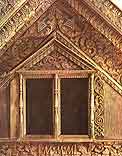
Carved pediment of a peasant's log hut (izba) with living-room window. Fragment. 1882. Nizhniy Novgorod Region |
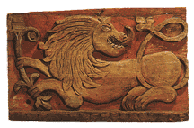
Frontal board of a peasant's “izba”. Detail. "Lion". 19th century. Nizhniy Novgorod Region |
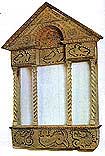
Platband of a living-room window of an “izba”. Second half of the19th centuries. Nizhniy Novgorod Region |
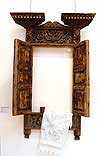
Platband of a window with shutters of an “izba”. Second half of the 19th centuries. Nizhniy Novgorod Region
|
An important architectural detail of every northern house was “okhlupen” - the ridge beam of the roof whose end, projecting over the facade, was hewn in the shape of a horse, duck or deer. In ancient times these figures, representing pagan gods, were thought to protect the house. In Russian folk sculpture the image of the horse was extremely popular. Toy horses were very common. In the nineteenth century carved wooden toy horses were made in many villages of the Russian North and the Povolzhye. These miniature wooden sculptures varied greatly in their shape and decoration. However, all of them, no matter whether made on the banks of the Mezen or in a Povolzhye village, were characterized by the high degree of stylization and the expressiveness of form, typical of Russian wooden sculpture as a whole.
Òhe specific manner of carving and painting the wooden toys was determined by the centuries-old traditions developed in each part of the country.
Russian craftsmen also created unique objects in which no direct connection with established traditions or conventional motifs can be traced. Of high artistic value, for instance, are the two intricately carved bird-houses shaped like an old man with a pipe and an old woman with a pail from Moscow Region.
|

Okhlupens (roof ridge). 19th centuries. Archangel Region |
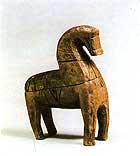
Toy horse. The beginning of the19th century Arkhangelsk area |

Birdhouse "Old man". 1870. Moscow Region |

Birdhouse "Old woman". 1870. Moscow Region |
A painting was occupied the big place with in appearance of fronts and interiors of houses. Its receptions as well as in a carving, are various. The painting of country interiors in Russian North Region has remained better. In 19th century, and it is frequent also in the first decades of the 20th century the painting covered all interior of northern “izba”. It became without preliminary drawing free picturesque blows of a brush, which were underlined then by whiting glares.
Floral patterns covered the doors, thelower part of the stove, the box covering the steps down to the cellar, the beam supporting the broad berth near the ceiling, the icon shelf in the right-hand corner opposite the door, the panels of cupboards and the surfaces of chests. An attractively painted distaff was placed on the bench by the window. In winter the decorated wooden parts of the harness were also hung on a special hanger at the side of the long bench running along the wall. Painted plates and dishes were arranged on the wooden ledges above the windows. The brightly painted cradle hanging from the middle of the ceiling was an indispensable part of the picturesque interior of a peasant house. Wooden ware with a painting stood on regiments over windows. In the winter, take for a drive on painted sledge.
|

Peasant cupboard. Late 19th century, Yaroslavl Region |
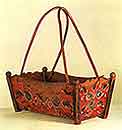
Cradle. Second half of 19th centuries. Arkhangelsk Region |
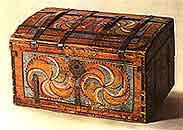
Chest. Late 19th century. Arkhangelsk Region |
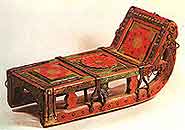
Shrovetide sledges. Early 19th century. Arkhangelsk Region
|
|


